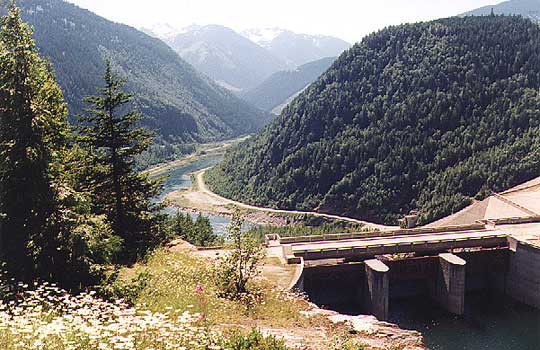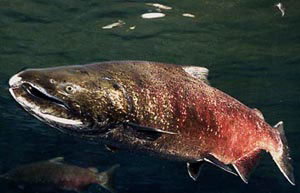
Data:
| Hydroelectric
Power |
Hydro in the Northwest: While hydroelectricity makes up only 10% of the nation's energy profile, in the Northwest we derive most of our power from that source. For both EWEB and the BPA, over 66% of the total power resources comes from hydroelectric generated power plants, such as the Grand Coulee, John Day, Chief Joseph, Ice Harbor, McNary, Smith Creek, or Carmon-Smith projects. EWEB contracts 3.6% of its electricity from the Grant County PUD, which runs the Priest Rapids and the Wanapum hydroelectric plants on the Columbia river. Another 0.9% of EWEB's total electricity load is generated by the Mica dam in British Columbia through a treaty with BC Hydro.
Benefits to the Region: Hydroelectric power is considered a "renewable" energy. This type of energy production is free from air pollution and the primary fuel source (water) is not depleted in the generation process. Also, hydro plants have a long generation life, generally about 50 years. |
Mica Dam, British Columbia
|
|
The Downside: Dams have a remarkable impact on water downstream. In regards to flood protection, dams are highly successful. Unfortunately, this means that water flowing downstream is deeper and faster. These factors cause the reduction in nutrients or sediment (turbidity) in the water and also affect spawning practices. Dams also cause fluctuations in temperature of water. Changes in water temperature affect oxygen absorption, which is detrimental to salmon and other fish populations. Due to the reduction in floods, as a result of the construction of a dam, the necessary nutrients and sediments do not replenish with the natural floodplain. This can affect the bio diversity of riparian vegetation along a waterway. Dams also block passage along the waterway, making it difficult for salmon to return upstream for spawning. Fish ladders, although somewhat helpful to salmon passage, are not located at every dam (Grand Coulee for example). This has greatly decreased current salmon populations.
|

